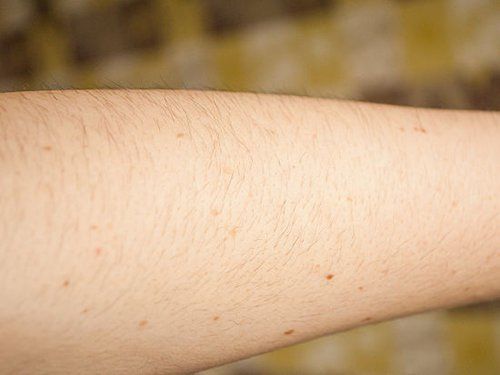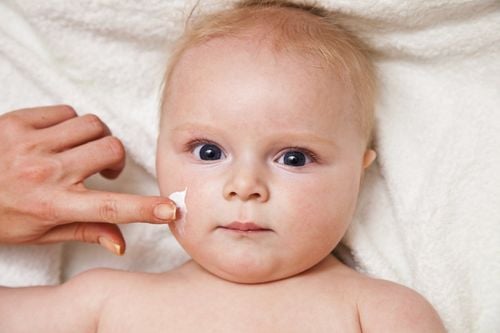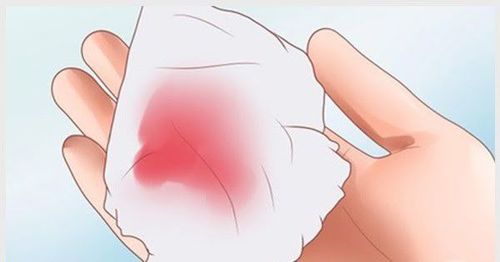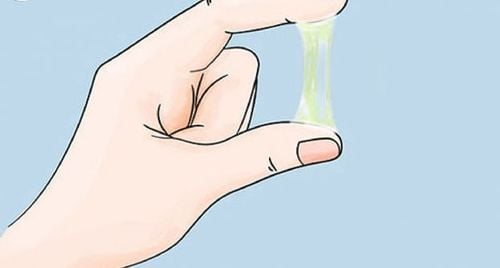This is an automatically translated article.
The article was professionally consulted by resident Doctor Duong Van Sy - Department of Pediatrics - Neonatology - Vinmec Hai Phong International General Hospital. Doctor has 09 years of experience in the field of Pediatrics.A birthmark is a color-changing patch on the skin that appears when a baby is born or develops during the first few weeks of life. Birthmarks are very common in babies and most do not require any treatment, they are mostly harmless or even disappear on their own or shrink over time as the baby gets older. However, sometimes birthmarks are linked to other underlying health problems.
1. What is a birthmark?
A birthmark is a benign, congenital abnormality in the skin that appears at birth or shortly after birth — usually within the first month. They can appear anywhere on the skin. The nature of birthmarks is thought to result from an overgrowth of blood vessels, melanocytes, smooth muscle, fat, fibroblasts or keratinocytes in the skin and subcutaneous tissue.The cause of birthmarks in babies is so far unclear and not preventable. Some theories suggest that birthmarks appear due to a local imbalance in the factors that control the growth and migration of skin cells.
For the most part, birthmarks in babies are harmless and some may fade or disappear over time even without any treatment. Rarely, certain types of birthmarks can be a sign of a serious underlying medical condition. This should be suspected if birthmarks develop in large numbers or in clusters, persisting as the child grows.
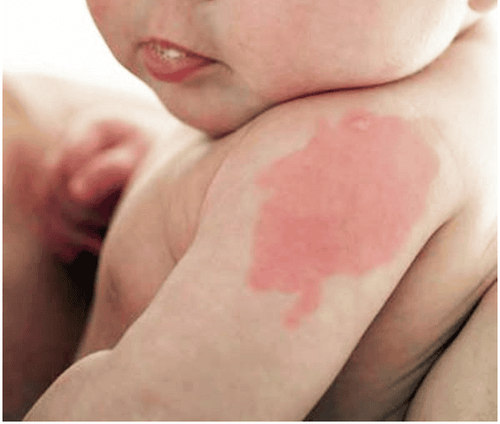
2. Types of birthmarks in babies
There are different types of birthmarks encountered in babies, which are described according to each type as follows:Salmon birthmarks (pink birthmarks, red birthmarks) These are flat, red or pink areas of skin that resemble pieces of fish. return. This type of birthmark is quite common where it is located on the eyelids, head or neck of the baby. The color of the birthmark will be more noticeable when the baby is crying but will usually fade by age 2 for birthmarks on the forehead or eyelids while it may take longer for birthmarks on the back of the head or neck.
Hematomas These are blood vessels that form a raised red lump on the surface of the skin that appears soon after birth and is usually bright red like a strawberry. This type tends to be more common in girls, premature babies (born before 37 weeks), low birth weight babies, and multiple births, such as twins.
Hemangiomas are observed to get larger in the first 6 to 12 months, then shrink and disappear by the age of 7. However, they can sometimes appear under the skin, turning blue or purple. At this point, hemangiomas may need treatment if they are affecting vision, breathing or function in the relevant organs.
Purple birthmarks These are birthmarks in newborns that are dark red or turn purple, like the color of wine, commonly found on the neck, cheeks, nose and lips of the baby observed since birth. . If your child has dark skin, the purple spots will look like dark patches of skin.
If the child grows up and these birthmarks do not improve, for cosmetic reasons, sometimes it is possible to lighten the color of the birthmark with laser treatment. In rare cases, birthmarks can become darker and rougher if left untreated, or this can be a sign of Sturge-Weber syndrome, Klippel-Trenaunay syndrome or a large but very large capillary malformation. rarely.
Coffee and milk stains These are flat, pale or dark brown patches similar in color to coffee milk that can be anywhere on the body and vary in size and shape. This birthmark may be considered a sign of neurofibromatosis type 1 if the child has 6 or more plaques.
Erythema A large, dark greenish-gray patch that looks like a bruise on a baby's thigh is also considered a type of birthmark. It is usually found in the lower back, upper arms or legs.
The rash is also present from birth, most common in infants with dark skin. Usually, this type of birthmark does not require any treatment because it is not a sign of an abnormal health condition and will clear up on its own by the time the child is 4 years old.
Congenital moles or congenital melanocyte nevi Congenital moles are brown or black moles caused by an overgrowth of pigment cells in the skin, look darker on darker skin and can raised bumps or hair growth, especially during puberty.
This condition can develop into skin cancer if the moles get larger, the risk increases the bigger they get. However, these moles may not need treatment unless there is a risk of turning into skin cancer.
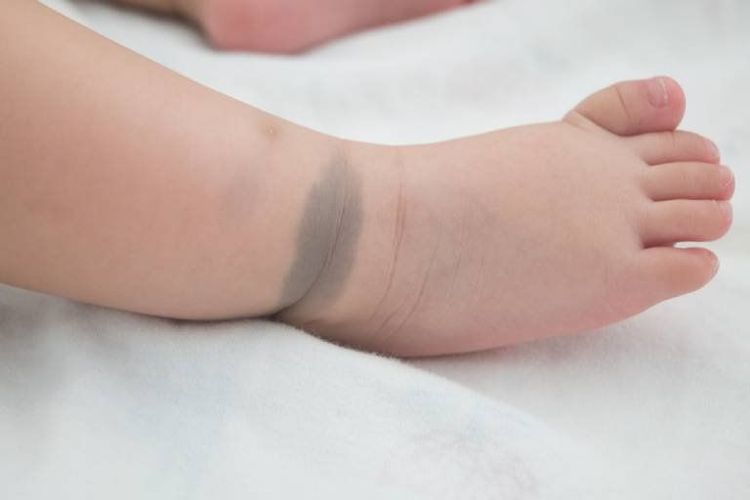
3. How to check for birthmarks early?
Dermatologists at a children's hospital can usually diagnose the type of birthmark on a child's skin based on an imaging exam. If the doctor needs more information about the nature or type of birthmark or if the birthmark or type of birthmark suggests another medical condition, additional testing may be recommended.Medical history When visiting a dermatologist, the condition of the birthmark is examined in detail on family members or other medical conditions that are also sometimes associated with birthmarks, such as cancer. leather letter.
This information helps the physician evaluate the request for additional testing. For example, if your child has some coffee-milk spots and someone in the family also has neurofibromatosis type 1, your doctor will also recommend that your child get tested for the condition.
In addition, questions about changes in the size, color, shape or texture of the birthmark should also be noted. Some birthmarks, such as hemangiomas, grow very quickly and can double or triple in size in just a few weeks, while many other types of birthmarks do not grow or change shape at all. after a long time. However, any birthmark that is changing rapidly is worth noting.
Visit A dermatological exam is a thorough examination of a child's skin from head to toe. At the same time, doctors will also look for any signs or symptoms that may suggest any suspected medical condition.
In addition, doctors pay close attention to birthmarks in babies that are located on sensitive areas — such as lips, mouth, and eyes — because they can affect the development and function of organs. this.
Ultrasound Skin ultrasound is a painless, non-invasive imaging test that uses high-frequency sound waves to create images of structures inside the body. If a dermatologist examines a birthmark or a large group of birthmarks that are highly suspicious, an ultrasound of the skin will be ordered, showing what the underlying structure of the birthmark is and whether the parts Other body parts may or may not be involved.
Magnetic Resonance Scan Magnetic resonance imaging (MRI) scans use a magnetic field and radio waves to create detailed two- and three-dimensional images of tissues inside the body. Your doctor may recommend an MRI to visualize the extent or nature of a certain type of birthmark, such as a deep hemangioma, if an ultrasound does not provide enough information.
In addition, MRI is also used to provide images of the brain if the doctor suspects that the abnormal cell growth associated with the birthmark may be present in other parts of the body such as if the child has a very large congenital nevus birthmark.
Biopsy Dermatologists may recommend a biopsy if a baby has a mole that looks abnormal at birth. During the biopsy, your doctor will remove a small section of skin at the birthmark site and send it to a lab, where it will be examined under a microscope.
Skin biopsies always have to take place in the hospital and take 15 to 30 minutes to do. Doctors inject a local anesthetic into the skin around the birthmark to eliminate pain during the procedure. Sometimes the doctor will need to make a small incision to remove the suspected malignancy and then the wound will be sutured and bandaged. The skin usually heals in 7 to 10 days and the sutures are removed.
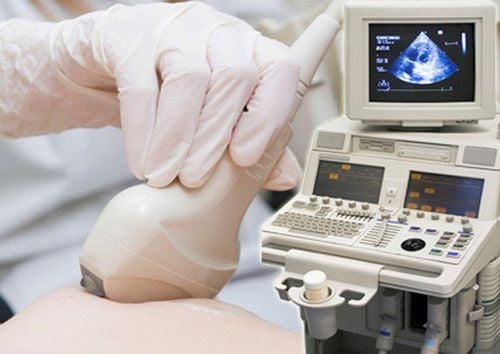
4. How to treat birthmarks for children?
Most birthmarks in newborns do not require treatment, but some are for medical or cosmetic reasons, especially when this is a factor that causes concern for parents and children themselves. children grow up.Current birthmark treatments include:
Medical – ie medication – to reduce blood flow to the birthmark, which can slow growth and make it lighter in color.
Laser therapy – uses heat and light energy to make birthmarks smaller and lighter. This method only works best if started between 6 months and 1 year old. Surgery - to remove the birthmark invasively but with consideration because of the potential for scarring with less aesthetic appeal. In summary, some types of birthmarks in babies last a lifetime while others fade away as the child gets older without treatment. Therefore, before the birth of birthmarks, parents can rest assured that they are only cosmetic in most cases. However, it is also important to remember that a small number of birthmarks have a higher risk of complications or are associated with underlying systemic diseases that require further identification and management.

Gathering a team of leading pediatricians: including leading experts with high professional qualifications (professors, associate professors, doctors, Master's degree), experienced, worked at major hospitals such as Bach Mai, 108.. The doctors are all well-trained, professional, conscientious, knowledgeable about young psychology. In addition to domestic pediatric specialists, the Department of Pediatrics also has the participation of foreign experts (Japan, Singapore, Australia, USA) who are always pioneers in applying the latest and most effective treatment regimens. . Comprehensive services: In the field of Pediatrics, Vinmec provides a series of continuous medical examination and treatment services from Newborn to Pediatric and Vaccine,... according to international standards to help parents take care of their baby's health from birth to childhood. Advanced techniques: Vinmec has successfully deployed many specialized techniques to make the treatment of difficult diseases in pediatrics more effective: neurosurgery - skull, stem cell transplant blood in cancer treatment. Professional care: In addition to understanding children's psychology, Vinmec also pays special attention to the children's play space, helping them to play comfortably and get used to the hospital's environment, cooperate in treatment, improve the efficiency of medical treatment.
Please dial HOTLINE for more information or register for an appointment HERE. Download MyVinmec app to make appointments faster and to manage your bookings easily.
Reference sources: nyulangone.org, babycenter.com




